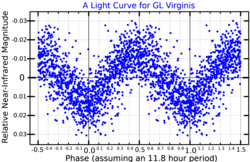GL Virginis
| Observation data Epoch J2000 Equinox J2000 | |
|---|---|
| Constellation | Virgo |
| Right ascension | 12h 18m 59.3999s[2] |
| Declination | +11° 07′ 33.7702″[2] |
| Apparent magnitude (V) | 13.898[3] |
| Characteristics | |
| Spectral type | M5[4] |
| U−B color index | +1.065[5] |
| B−V color index | +1.88[5] |
| Variable type | Flare star |
| Astrometry | |
| Radial velocity (Rv) | 5.82[3] km/s |
| Proper motion (μ) | RA: −1269.771±0.056[6] mas/yr Dec.: 203.444±0.033[6] mas/yr |
| Parallax (π) | 154.6999 ± 0.0445 mas[6] |
| Distance | 21.083 ± 0.006 ly (6.464 ± 0.002 pc) |
| Absolute magnitude (MV) | 14.72[7] |
| Details | |
| Mass | 0.12[7] M☉ |
| Radius | 0.16[8] R☉ |
| Surface gravity (log g) | 5.0[9] cgs |
| Temperature | 3110[9] K |
| Metallicity [Fe/H] | 0.17[10] dex |
| Rotational velocity (v sin i) | 17[8] km/s |
| Other designations | |
| Database references | |
| SIMBAD | data |
GL Virginis, also known as G 12-30, is a star in the constellation of Virgo. It is a faint red dwarf, like more than 70% of the stars located within 10 parsecs of the Solar System; its magnitude visual magnitude is 13.898, making it impossible to see with the naked eye.
Located 21.1 light years away, GL Virginis has a spectral type of M4.5V and an effective temperature of approximately 3110 K.[9] Its luminosity (emitted in the visible section of the electromagnetic spectrum) is only one ten-thousandth compared to the Sun; however, since a significant fraction of its radiation is emitted as invisible infrared light, its bolometric luminosity increases to 0.5% of that of the Sun. Its mass is 12% that of the Sun[7] and its radius is 16% of the Sun.[8] It is a fairly rapid rotator: its rotational velocity is least 17 km/s,[8] which implies that it takes less than half a day to complete a rotation on its axis. The star is emitting a frequent flares, with at least five detected by 2019.[4]
The closest known star system to GL Virginis is Gliese 486, 6.4 light-years away.[11]
References
[edit]- ^ Díez Alonso, E.; Caballero, J. A.; Montes, D.; de Cos Juez, F. J.; Dreizler, S.; Dubois, F.; Jeffers, S. V.; Lalitha, S.; Naves, R.; Reiners, A.; Ribas, I.; Vanaverbeke, S.; Amado, P. J.; Béjar, V. J. S.; Cortés-Contreras, M.; Herrero, E.; Hidalgo, D.; Kürster, M.; Logie, L.; Quirrenbach, A.; Rau, S.; Seifert, W.; Schöfer, P.; Tal-Or, L. (January 2019). "CARMENES input catalogue of M dwarfs. IV. New rotation periods from photometric time series". Astronomy and Astrophysics. 621: A126. arXiv:1810.03338. Bibcode:2019A&A...621A.126D. doi:10.1051/0004-6361/201833316.
- ^ a b Brown, A. G. A.; et al. (Gaia collaboration) (August 2018). "Gaia Data Release 2: Summary of the contents and survey properties". Astronomy & Astrophysics. 616. A1. arXiv:1804.09365. Bibcode:2018A&A...616A...1G. doi:10.1051/0004-6361/201833051. Gaia DR2 record for this source at VizieR.
- ^ a b c "V* GL Vir". SIMBAD. Centre de données astronomiques de Strasbourg. Retrieved 25 December 2016.
- ^ a b Rodríguez Martínez, Romy; Lopez, Laura A.; Shappee, Benjamin J.; Schmidt, Sarah J.; Jayasinghe, Tharindu; Kochanek, Christopher S.; Auchettl, Katie; Holoien, Thomas W.-S. (2019), "A Catalog of M-dwarf Flares with ASAS-SN", The Astrophysical Journal, 892 (2): 144, arXiv:1912.05549, doi:10.3847/1538-4357/ab793a, S2CID 209323915
- ^ a b Mermilliod, J.-C. (1986). "Compilation of Eggen's UBV data, transformed to UBV (unpublished)". Catalogue of Eggen's UBV Data. Bibcode:1986EgUBV........0M.
- ^ a b c Brown, A. G. A.; et al. (Gaia collaboration) (2021). "Gaia Early Data Release 3: Summary of the contents and survey properties". Astronomy & Astrophysics. 649: A1. arXiv:2012.01533. Bibcode:2021A&A...649A...1G. doi:10.1051/0004-6361/202039657. S2CID 227254300. (Erratum: doi:10.1051/0004-6361/202039657e). Gaia EDR3 record for this source at VizieR.
- ^ a b c "The One Hundred Nearest Star Systems". 2012. Retrieved 25 December 2016.
- ^ a b c d Reiners, Ansgar; Basri, Gibor; Browning, Matthew (2009). "Evidence for Magnetic Flux Saturation in Rapidly Rotating M Stars" (PDF). The Astrophysical Journal. 692 (1): 538–545. arXiv:0810.5139. Bibcode:2009ApJ...692..538R. doi:10.1088/0004-637X/692/1/538. hdl:10871/10302. S2CID 15833388.
- ^ a b c Lépine, Sébastien (2013). "A Spectroscopic Catalog of the Brightest (J < 9) M Dwarfs in the Northern Sky". The Astronomical Journal. 145 (4): 102. arXiv:1206.5991. Bibcode:2013AJ....145..102L. doi:10.1088/0004-6256/145/4/102. S2CID 117144290.
- ^ Newton, Elisabeth R. (2014). "Near-infrared Metallicities, Radial Velocities, and Spectral Types for 447 Nearby M Dwarfs". The Astronomical Journal. 147 (1): 20. arXiv:1310.1087. Bibcode:2014AJ....147...20N. doi:10.1088/0004-6256/147/1/20. S2CID 26818462.
- ^ Stars within 15 light-years of Gliese & Jahreiss 1156 (The Internet Stellar Database)
| Stars |
| ||||||||||||
|---|---|---|---|---|---|---|---|---|---|---|---|---|---|
| |||||||||||||
| |||||||||||||
| Galaxies |
| ||||||||||||
| |||||||||||||
| |||||||||||||
Text is available under the CC BY-SA 4.0 license; additional terms may apply.
Images, videos and audio are available under their respective licenses.

